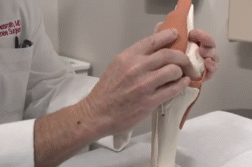BALTIMORE, Md. (Ivanhoe Newswire)— At one time, foot and ankle specialists would discourage patients with arthritis from getting a total joint replacement because of the risk of infection, and problems with early systems. Those patients had few choices, except to fuse the joint and lose mobility. But now, a new design for one ankle replacement system means patients—even those with severe deformities have more options.
Wendy-Rubin Fitzgerald has lived her entire life around horses, at one time competing in national arenas. But during a trail ride, a snake crossed her horse’s path, causing him to spook, throwing Wendy off.
“I always wore spurs. I had spurs, so I didn’t land flat. I landed on my ankle and the spur just trashed it,” Wendy recalled.
Wendy knew as soon as she tried to stand, she was in trouble.
“That step was the most painful, and it was also crunch, crunch,” Wendy illustrated.
Dr. Lew Schon Is an orthopedic surgeon and the co-inventor of the Zimmer total ankle replacement.
“All my cases are lateral approach. We cut the outer bone. Position it, get everything property aligned and correct the deformity,” explained Lew Schon, MD, Director of Orthopedic Innovation at Mercy Medical Center.
The Zimmer’s design is different from other companies and is made from a material called tantalum.
“That is a very special metal that inspires bone to grow into it,” clarified Dr. Schon.
Wendy had a rod holding her ankle together at first, but then had the Zimmer ankle replacement four years ago. She no longer rides but is active on her trainer’s farm with very few restrictions.
“He told me if I took care of it, I’d have it for life,” Wendy shared.
Dr. Schon says robotic testing on the Zimmer suggests the replacement will last about 15 years before the plastic parts in the ankle might need to be replaced. While his patients can resume many of their activities, Dr. Schon recommends his patients don’t run on the ankle to extend the life of the replacement.
Contributors to this news report include: Cyndy McGrath, Executive & Field Producer; Kirk Manson, Videographer; Roque Correa, Editor.
To receive a free weekly e-mail on Medical Breakthroughs from Ivanhoe, sign up at: http://www.ivanhoe.com/ftk
MEDICAL BREAKTHROUGHS
RESEARCH SUMMARY
TOPIC: ZIMMER TOTAL ANKLE REPLACEMENT: NEW OPTION
REPORT: MB #4772
BACKGROUND: Ankle replacements in the U.S. more than doubled last year due to advances in ankle implants, or prostheses. Total ankle replacement surgery, or ankle arthroplasty, involves replacing a damaged joint with an artificial joint. The procedure improves function for people who cannot perform everyday activities without experiencing pain. The most common causes of this pain are arthritis and previous injuries. Patients undergoing ankle replacement are typically in their forties through sixties. Ankle implants generally last at least a decade and are expected to improve with today’s technologically advanced prostheses and surgical techniques.
(Source: https://www.foothealthfacts.org/article/ankle-replacement-rapidly-on-the-rise)
ANKLE FUSION VS ANKLE REPLACEMENT: The only treatment option for patients suffering with end-stage ankle arthritis was known as ankle fusion. This treatment eliminates the joint to relieve pain but has some disadvantages. It eliminates range of motion; can result in an abnormal gait and can increase long-term risk of arthritis developing in adjacent hindfoot joints. With ankle replacements becoming more popular, researchers compared the two treatments for outcomes. They found a significantly higher rate of readmission and wound infection in ankle fusion patients; a significantly higher rate of reoperation for subtalar fusion among ankle fusion patients (2.8%) than with ankle replacement patients (0.7%); and a lower level of patient satisfaction among ankle fusion patients. With ankle replacement, the damaged joint is replaced with an implant. The new, artificial joint can relieve pain and closely mimic the natural movement of a healthy ankle. Patients are typically able to walk, pain-free, with a normal gait within a year of surgery.
(Source: https://www.myankle.com/fuse-or-replace/)
NEW OPTION FOR ANKLE REPLACEMENT: The Zimmer Biomet Trabecular Metal Total Ankle is designed to reproduce the ankle’s natural flexibility and motion. This implant features a low-profile design, a lateral surgical approach, and an industry-first Prolong Highly Crosslinked Polyethylene. The device is designed to provide joint mobility by restoring alignment, reducing pain, and preserving the flexion/extension movement within the ankle joint. A lateral trans fibular approach is used to potentially reduce the risk of post-operative complications that result from stressing neurovascular structures. The anatomic center of rotation is fully visualized by surgeons and can be more precisely replicated through this approach.
FOR MORE INFORMATION ON THIS REPORT, PLEASE CONTACT:
DAN COLLINS
MERCY MEDICAL CENTER
410-332-9714
If this story or any other Ivanhoe story has impacted your life or prompted you or someone you know to seek or change treatments, please let us know by contacting Marjorie Bekaert Thomas at mthomas@ivanhoe.com




